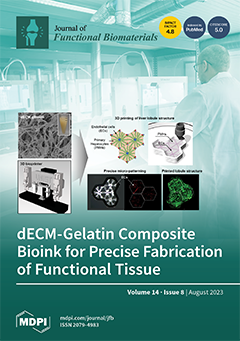The epidermal growth factor receptor (EGFR) is vital for many different types of cancer. Nimotuzumab (NmAb), an anti-EGFR monoclonal antibody (mAb), is used against some of EGFR-overexpressed cancers in various countries. It targets malignant cells and is internalized via receptor-mediated endocytosis. We hypothesized
[...] Read more.
The epidermal growth factor receptor (EGFR) is vital for many different types of cancer. Nimotuzumab (NmAb), an anti-EGFR monoclonal antibody (mAb), is used against some of EGFR-overexpressed cancers in various countries. It targets malignant cells and is internalized via receptor-mediated endocytosis. We hypothesized that mAb-nanoparticle conjugation would provide an enhanced therapeutic efficacy, and hence we conjugated NmAb with 27 nm spherical gold nanoparticles (AuNPs) to form AuNP-NmAb nanoconjugates. Using biophysical and spectroscopic methods, including ultraviolet-visible spectroscopy (UV-Vis), transmission electron microscopy (TEM), dynamic light scattering (DLS), nanoparticle tracking analysis (NTA), sodium dodecyl sulfate-polyacrylamide gel electrophoresis (SDS-PAGE), and Fourier-transform infrared spectroscopy (FTIR), the AuNP-NmAb complex was characterized. Furthermore, in vitro studies were performed using a medium-level EGFR-expressing skin cancer cell (A431, EGFR
medium) and low-level EGFR-expressing lung cancer cell (A549, EGFR
low) to evaluate anti-tumor and cellular uptake efficiency via MTT assay and single-particle inductively coupled plasma mass spectrometry (spICP-MS), respectively. In comparison to NmAb monotherapy, the AuNP-NmAb treatment drastically reduced cancer cell survivability: for A431 cells, the IC
50 value of AuNP-NmAb conjugate was 142.7 µg/mL, while the IC
50 value of free NmAb was 561.3 µg/mL. For A549 cells, the IC
50 value of the AuNP-NmAb conjugate was 163.6 µg/mL, while the IC
50 value of free NmAb was 1,082.0 µg/mL. Therefore, this study highlights the unique therapeutic potential of AuNP-NmAb in EGFR+ cancers and shows the potential to develop other mAb nanoparticle complexes for a superior therapeutic efficacy.
Full article






